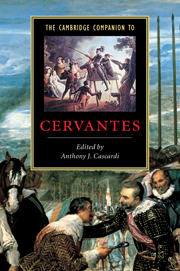Book contents
- Frontmatter
- 1 Introduction
- 2 The historical and social context
- 3 Cervantes and the Italian Renaissance
- 4 Don Quixote and the invention of the novel
- 5 The influence of Cervantes
- 6 Cervantes’ other fiction
- 7 Writings for the stage
- 8 Humor and violence in Cervantes
- 9 Psyche and gender in Cervantes
- 10 Cervantes and the New World
- Appendix: electronic editions and scholarly resources
- Index
- Series List
3 - Cervantes and the Italian Renaissance
Published online by Cambridge University Press: 28 May 2006
- Frontmatter
- 1 Introduction
- 2 The historical and social context
- 3 Cervantes and the Italian Renaissance
- 4 Don Quixote and the invention of the novel
- 5 The influence of Cervantes
- 6 Cervantes’ other fiction
- 7 Writings for the stage
- 8 Humor and violence in Cervantes
- 9 Psyche and gender in Cervantes
- 10 Cervantes and the New World
- Appendix: electronic editions and scholarly resources
- Index
- Series List
Summary
During the last months of 1569, the twenty-two year-old Cervantes travels to Italy and enters the service of the soon-to-be Cardinal Giulio Acquaviva in Rome. Italian sojourns were almost de rigueur for Spanish poets, writers of prose fiction, and humanists during the early modern period. Cervantes' voyage, then, resembled the ones of Acuña, Aldana, the brothers Argensola, Cetina, Figueroa, Garcilaso, Hurtado de Mendoza, Medrano, Santillana, and Villamediana. Such voyages were facilitated by the fact that the kingdom of Naples was part of the Spanish empire, while other regions of the peninsula were under Habsburg influence. Cervantes came to Italy after studying in Madrid with the Spanish humanist Juan López de Hoyos and after writing his first verse compositions, which imitated Garcilaso, using his metrical forms, adjectives, and themes. Cervantes' brief humanistic training, and his interest in Garcilaso, who was deeply influenced by the Italian Renaissance, prepares him for an Italian sojourn. While it is said that López de Hoyos taught Cervantes an Erasmism that was no longer tolerated in Spain, Rome would reveal to him the ecclesiastic pomp, ritual, and luxuriant majesty that the humanist from Rotterdam often criticized. It was also a Rome teeming with ruins, which impelled humanists and artists of the Renaissance to turn to archeological pursuits, to focus their attention on rediscovering antiquity, finding in the ancients “a powerful impetus to revive the contemporary world in light of its accomplishments.”
- Type
- Chapter
- Information
- The Cambridge Companion to Cervantes , pp. 32 - 57Publisher: Cambridge University PressPrint publication year: 2002
- 3
- Cited by



